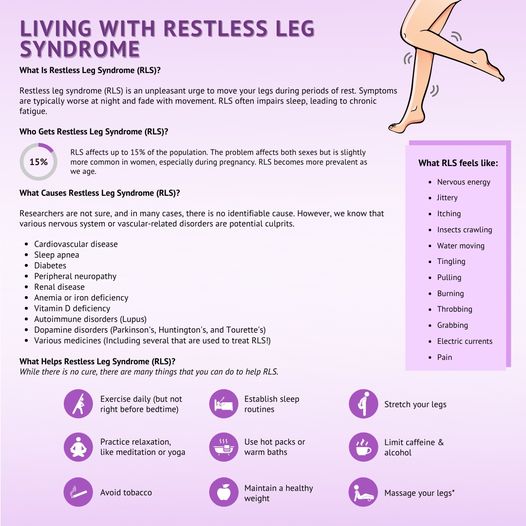Discover the untold truth behind Restless Leg Syndrome and why misconceptions surround this mysterious condition. Unravel the mystery today!
Table of Contents
- Introduction: What is Restless Legs Syndrome (RLS)?
- Understanding Restless Legs Syndrome
- Misunderstandings Around RLS
- The Role of Minerals and Vitamins
- Tension Headache vs. Restless Legs Syndrome
- Restless Legs and Sleep Problems
- Diagnosing RLS
- Treating Restless Legs Syndrome
- How Does RLS Feel for Kids?
- Conclusion: Understanding and Empathy
- FAQs
Introduction: What is Restless Legs Syndrome (RLS)?
Restless Leg Syndrome (RLS) is a condition that can make your legs feel very uncomfortable. For people with RLS, the sensation in their legs is hard to describe, almost like an irresistible urge to move them. This constant need to move the legs can be frustrating and disturbing, especially when trying to relax or sleep. Understanding what RLS is and how it affects someone’s daily life is important in offering support and empathy towards those experiencing it.
Understanding Restless Legs Syndrome
Restless Legs Syndrome, commonly known as RLS, is a condition where a person feels an overwhelming urge to move their legs. It’s like having an itch you just have to scratch, but in your legs. The sensation is often uncomfortable, making it hard to sit still or relax.
The Feeling of RLS
Imagine a tingly, jittery, or prickly feeling in your legs that won’t go away. It’s not painful, but it’s really annoying. This sensation usually gets worse when you’re resting, like when you’re sitting or laying down, and it can make you feel restless.
Who Gets RLS?
RLS can affect anyone, including kids, teens, and adults. It’s more common in adults, especially pregnant women and older adults, but kids can have it too. If you feel like you just can’t sit still because your legs are bothering you, you might have RLS.
Misunderstandings Around RLS
Restless Legs Syndrome (RLS) is often misunderstood, leading to misconceptions about this condition. Addressing these misunderstandings is crucial to raising awareness and providing accurate information to those affected by RLS.

Image courtesy of wilmingtonclinic.com via Google Images
Myth vs. Fact
One common misconception about RLS is that it is merely a psychological issue or a result of being restless. In reality, RLS is a neurological disorder characterized by uncomfortable sensations in the legs, often accompanied by an uncontrollable urge to move them. It is not a choice or a figment of one’s imagination. Understanding the true nature of RLS can help dispel myths surrounding this condition.
Why People Get Confused
People may struggle to understand RLS because its symptoms can vary in intensity and may be challenging to describe. Additionally, the lack of awareness and education about RLS can contribute to misunderstandings. Without proper information, it’s easy for misconceptions to abound, further hindering accurate recognition and support for those with RLS.
The Role of Minerals and Vitamins
When it comes to managing Restless Legs Syndrome (RLS), understanding the role of minerals and vitamins is essential. Certain nutrients play a vital role in helping to alleviate the uncomfortable sensations associated with RLS. Let’s explore how these elements can make a difference in managing the symptoms of RLS.
Magnesium Benefits
Magnesium is a mineral that can have a positive impact on RLS symptoms. It helps to relax muscles and may reduce the frequency and intensity of leg discomfort. Adding magnesium-rich foods like nuts, seeds, and leafy greens to your diet can be beneficial for managing RLS.
Iron Supplements
Iron deficiency can contribute to the development of RLS symptoms. Your doctor may recommend iron supplements if blood tests show that you have low iron levels. By increasing your iron intake, you may experience improvements in the sensations that RLS causes in your legs.
Vitamin D
Vitamin D deficiency has also been linked to RLS. Ensuring that you have sufficient levels of vitamin D in your body may help in reducing the discomfort associated with this condition. Spending time outdoors in the sunlight or incorporating vitamin D-rich foods like fatty fish and fortified dairy products into your diet can be beneficial.
Tension Headache vs. Restless Legs Syndrome
When it comes to health issues, there are various conditions that can affect people in different ways. Two common problems that people may experience are tension headaches and restless legs syndrome. Let’s take a closer look at these two conditions and understand the differences between them.

Image courtesy of www.australiawidefirstaid.com.au via Google Images
What’s a Tension Headache?
A tension headache is a type of headache that many people have experienced at some point. It often feels like a dull, aching pain on both sides of the head or at the back of the head and neck. Tension headaches can be triggered by stress, lack of sleep, or poor posture.
Understanding the Difference
On the other hand, restless legs syndrome (RLS) is a completely different condition. RLS is a neurological disorder characterized by an irresistible urge to move the legs, often accompanied by uncomfortable sensations. These sensations are usually worse at night and can make it hard for people to fall asleep.
Restless Legs and Sleep Problems
Restless Leg Syndrome (RLS) can be more than just a feeling of discomfort in your legs. It can also affect your ability to get a good night’s sleep. When someone has RLS, the urge to move their legs can be overwhelming, especially during the evening or nighttime when trying to wind down and relax.
Challenges with Good Sleep
Having RLS can disrupt sleep patterns, making it difficult to fall asleep or stay asleep through the night. The constant need to move your legs can keep you awake or wake you up multiple times during the night, leading to feelings of exhaustion the next day. This lack of quality sleep can impact your mood, ability to focus, and overall well-being.
Is it RLS or Sleep Apnea?
While both RLS and sleep apnea can interfere with getting a good night’s sleep, they are separate conditions with distinct symptoms. RLS is characterized by uncomfortable sensations in the legs that prompt the need to move them, while sleep apnea involves pauses in breathing during sleep, leading to fragmented sleep and daytime fatigue. If experiencing symptoms of either RLS or sleep apnea, it’s important to consult with a healthcare provider for proper diagnosis and treatment.
Diagnosing RLS
When it comes to diagnosing Restless Legs Syndrome (RLS), doctors follow a specific process to determine if someone has this condition. Let’s take a closer look at what happens during a doctor’s visit and what signs and symptoms they look for to identify RLS.
| Reason | Explanation |
|---|---|
| Lack of Awareness | Many people are unaware of Restless Legs Syndrome (RLS) and its symptoms, leading to misunderstandings and misdiagnosis. |
| Misleading Name | The term “Restless Legs Syndrome” may trivialize the condition and lead some to believe it is not a serious or real medical disorder. |
| Symptoms Can Be Misinterpreted | The symptoms of RLS – such as tingling, itching, or creepy-crawly sensations in the legs – can be mistaken for other conditions, leading to confusion. |
| Variable Severity | RLS symptoms can vary in severity from mild to severe, making it difficult for some to understand the impact it can have on a person’s quality of life. |

Image courtesy of ca.viasox.com via Google Images
Visiting the Doctor
When you go to see a doctor about your legs feeling uncomfortable or restless, they will ask you questions about how your legs feel and when these sensations occur. It’s essential to be honest and share all the details about your symptoms so that the doctor can make an accurate assessment.
During the visit, the doctor may also perform a physical examination to rule out other possible causes of your leg discomfort. They may check for any underlying medical conditions that could be contributing to your symptoms.
What Doctors Look For
Doctors will look for specific signs and symptoms to help diagnose RLS. These may include a strong urge to move your legs, especially when you are at rest, and relief when you move your legs. Other common indicators doctors may consider are leg discomfort that worsens in the evening or at night and leg movements that disrupt your sleep.
In some cases, doctors may order additional tests or evaluations to confirm the diagnosis of RLS. These tests may include blood tests to check for iron deficiency or other nutrient deficiencies that could be contributing to your symptoms.
It’s important to work closely with your doctor to accurately diagnose RLS and develop a treatment plan that works best for you. Remember, open communication and honesty about your symptoms are key to receiving the care you need for managing RLS effectively.
Treating Restless Legs Syndrome
When it comes to managing Restless Legs Syndrome (RLS), there are various approaches that can help alleviate the discomfort and restlessness in your legs. From lifestyle changes to supplements, treating RLS is possible with the right strategies. Here are some ways to address RLS symptoms:
Lifestyle Changes and Home Remedies
Simple lifestyle modifications can go a long way in reducing the discomfort associated with RLS. Establishing a regular sleep routine, engaging in regular physical activity, and avoiding stimulants like caffeine and nicotine before bedtime can help improve symptoms. Additionally, practicing relaxation techniques such as yoga or deep breathing exercises before bed may also promote better sleep and lessen RLS sensations.
When Do You Need Iron Supplements?
Iron deficiency has been linked to Restless Legs Syndrome, and in some cases, iron supplements may be recommended to help manage RLS symptoms. If blood tests reveal low iron levels or if you have iron-deficiency anemia, your doctor may suggest iron supplementation. It’s essential to follow your healthcare provider’s guidance and dosage instructions when taking iron supplements to ensure safety and effectiveness in managing your RLS.
How Does RLS Feel for Kids?
Have you ever felt like your legs just won’t stop moving, even when you want them to be still? That’s what it’s like for kids who have Restless Legs Syndrome (RLS). This condition can make your legs feel very uncomfortable, almost like they have ants crawling inside them. It’s not just about feeling restless; it’s about feeling strange sensations in your legs that make you want to move them constantly.

Image courtesy of asterclinic.ae via Google Images
Kids’ Experiences with RLS
Imagine trying to sit still in class but feeling like you have to jiggle your legs or get up and walk around. Kids with RLS often struggle to focus because their legs feel so weird. It can be frustrating and make it hard to relax or fall asleep at night. Your legs might ache, tingle, or even burn, making it tough to get comfortable.
Conclusion: Understanding and Empathy
It’s essential to understand that not all conditions can be seen with the naked eye. Restless Legs Syndrome (RLS) is a perfect example of this. People who have RLS may look fine on the outside, but they might be struggling with uncomfortable sensations in their legs. That’s why empathy and understanding are crucial when it comes to dealing with individuals with RLS.
Why Understanding is Important
By understanding what RLS feels like and how it can impact someone’s life, we can be more compassionate and supportive. Imagine if your legs felt tingly or itchy all the time, making it hard to relax or sleep. Wouldn’t you want others to show empathy and kindness towards you?
Show Kindness to Those with RLS
Being kind to someone with RLS can make a world of difference. Simple gestures like offering a supportive ear, helping them find ways to feel more comfortable, or just being patient when they need to adjust their legs can go a long way in showing that you care.
Remember, just because you can’t see someone’s pain doesn’t mean it’s not real. By spreading awareness and practicing empathy, we can create a more understanding and inclusive world for everyone, including those living with conditions like RLS.
FAQs
Can kids get RLS too?
Yes, kids can have RLS just like adults. It’s important to talk to a grown-up if your legs feel uncomfortable often.
Is RLS just about feeling restless?
RLS is more than feeling restless. It can make your legs feel very uncomfortable or tingly. It’s not a normal feeling like when you’re just wiggling around in your seat.
Why do people not understand RLS?
Many people don’t know about RLS, so they might not understand how it feels. It’s like when you try to explain something new to your friends, and they just don’t get it at first.
How do doctors know you have RLS?
Doctors listen to your symptoms and sometimes do tests to find out if it’s RLS. They ask you questions about how your legs feel and may do some tests to be sure.
What can help calm my legs down?
Some vitamins, minerals, and stretches can help calm your legs. Eating healthy foods, like veggies and fruits, and doing leg exercises can make your legs feel better. Sometimes, doctors also recommend taking special vitamins or minerals to help with RLS.





